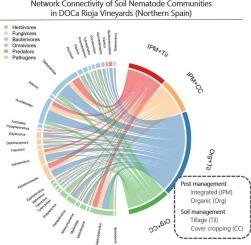基于元条形码的土壤线虫群落特征及其在葡萄栽培土壤健康评估中的应用
IF 7
2区 环境科学与生态学
Q1 ENVIRONMENTAL SCIENCES
引用次数: 0
摘要
农业实践深刻地影响着土壤健康,然而可用于评估这些影响的工具仍然有限,需要进一步完善。土壤线虫因其在养分循环中的作用和对环境变化的敏感性而成为农业生态系统健康的重要生物指标。虽然传统的土壤群落评估依赖于基于形态的鉴定,但分子技术的进步,如高通量测序(HTS)元条形码,使更全面和精细的表征成为可能。本研究评估了害虫和土壤管理措施对DOCa Rioja葡萄园(西班牙北部)土壤线虫群落的影响。我们假设,与综合虫害管理(IPM)和耕作做法相比,有机葡萄栽培和覆盖种植可以提高线虫多样性、食物网复杂性和土壤健康指标。我们利用HTS元条形码技术验证了这一点,鉴定了114个线虫分类群,以评估57个葡萄园的线虫多样性、营养成分和网络连通性。我们还计算了多样性指标和基于线虫的指数,并分析了关键的非生物土壤性质,以探讨它们对线虫群落结构的影响。我们的研究结果表明,有机葡萄栽培显著提高了线虫多样性(P <;0.001),食物网复杂性和生态稳定性,这反映在显著更高的(P <;0.01)成熟度指数(MI)和结构指数(SI)值,以及较低(P <;0.01)基础指数(BI)值。此外,有机葡萄园表现出更大的网络连通性,表明比IPM更具结构性和弹性的土壤食物网。相比之下,耕作和覆盖对线虫群落结构和土壤健康指数的影响有限,表明在研究条件下,对线虫介导的土壤功能的影响较弱。这些发现强调了有机葡萄栽培在提高土壤生物多样性和生态稳定性方面的益处,加强了可持续耕作方式在保持土壤健康方面的作用。此外,本研究强调了线虫DNA元条形码作为土壤健康评估的强大工具的潜力,为不同管理策略下的土壤线虫群落提供了全面、精细的视角。本文章由计算机程序翻译,如有差异,请以英文原文为准。

Metabarcoding-based characterization of soil nematode communities to asses soil health in viticulture
Agricultural practices profoundly impact soil health, yet the tools available to assess these effects remain limited and require further refinement. Soil nematodes are valuable bioindicators of agroecosystem health due to their role in nutrient cycling and sensitivity to environmental changes. While traditional soil community assessments have relied on morphology-based identification, advances in molecular techniques, such as high-throughput sequencing (HTS) metabarcoding, enable more comprehensive and fine-scale characterizations. This study evaluated how pest and soil management practices influence soil nematode communities in DOCa Rioja vineyards (Northern Spain). We hypothesized that organic viticulture and cover cropping would enhance nematode diversity, food web complexity, and soil health indicators compared to integrated pest management (IPM) and tillage practices. We applied HTS metabarcoding to test this, identifying 114 nematode taxa to assess nematode diversity, trophic composition, and network connectivity across 57 vineyards. We also calculated diversity metrics and nematode-based indices and analyzed key abiotic soil properties to explore their influence on nematode community structure. Our results show that organic viticulture significantly enhanced nematode diversity (P < 0.001), food web complexity, and ecological stability, as reflected in significantly higher (P < 0.01) Maturity Index (MI) and Structure Index (SI) values, along with lower (P < 0.01) Basal Index (BI) values. Additionally, organic vineyards exhibited greater network connectivity, indicating a more structured and resilient soil food web than IPM. In contrast, tillage and cover cropping had limited effects on nematode community structure and soil health indices, suggesting a weaker influence on nematode-mediated soil functions under the studied conditions. These findings underscore the benefits of organic viticulture in enhancing soil biodiversity and ecological stability, reinforcing the role of sustainable farming practices in maintaining soil health. Furthermore, this study highlights the potential of nematode DNA metabarcoding as a robust tool for soil health assessment, providing a comprehensive, fine-scale perspective on soil nematode communities across different management strategies.
求助全文
通过发布文献求助,成功后即可免费获取论文全文。
去求助
来源期刊

Ecological Indicators
环境科学-环境科学
CiteScore
11.80
自引率
8.70%
发文量
1163
审稿时长
78 days
期刊介绍:
The ultimate aim of Ecological Indicators is to integrate the monitoring and assessment of ecological and environmental indicators with management practices. The journal provides a forum for the discussion of the applied scientific development and review of traditional indicator approaches as well as for theoretical, modelling and quantitative applications such as index development. Research into the following areas will be published.
• All aspects of ecological and environmental indicators and indices.
• New indicators, and new approaches and methods for indicator development, testing and use.
• Development and modelling of indices, e.g. application of indicator suites across multiple scales and resources.
• Analysis and research of resource, system- and scale-specific indicators.
• Methods for integration of social and other valuation metrics for the production of scientifically rigorous and politically-relevant assessments using indicator-based monitoring and assessment programs.
• How research indicators can be transformed into direct application for management purposes.
• Broader assessment objectives and methods, e.g. biodiversity, biological integrity, and sustainability, through the use of indicators.
• Resource-specific indicators such as landscape, agroecosystems, forests, wetlands, etc.
 求助内容:
求助内容: 应助结果提醒方式:
应助结果提醒方式:


